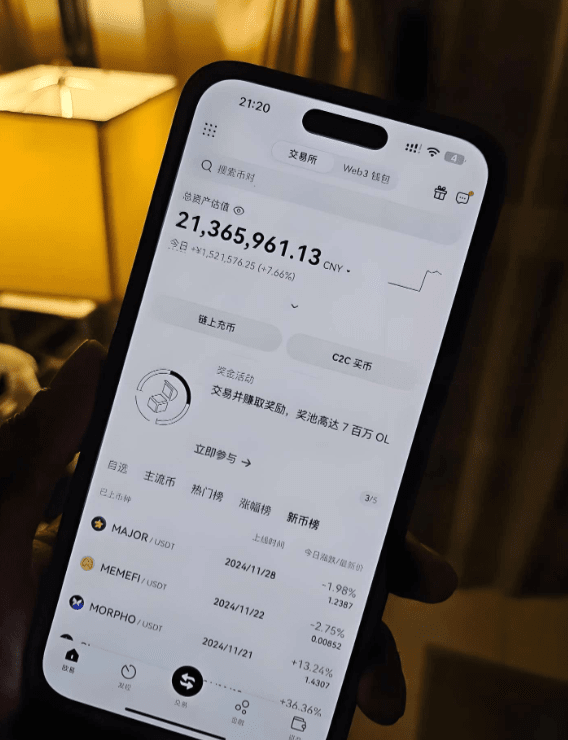A cryptocurrency veteran who earned 40 million in ten years tells you what to pay attention to in the crypto world!
In fact, once you get the hang of trading cryptocurrencies, life feels like enlightenment!
Ten years ago, when I first entered the cryptocurrency world, like most retail investors, my profits and losses seemed entirely based on luck, and I couldn't grasp the patterns.
However, after spending a few years in the cryptocurrency world, through continuous learning and absorption, with the constant sharing and guidance from masters and seniors, I finally started to understand and form my own investment system!
Today I will share my trading strategy and insights with friends in the cryptocurrency world.
Six survival rules for short-term cryptocurrency trading:
1. Wait for a clear trend before acting.
- After a high-level consolidation, it’s easier to make new highs; after a low-level consolidation, there’s a high probability of making new lows.
- Don’t rush to trade blindly during consolidation; wait until prices break through key positions before acting.
2. Don’t force trades in a fluctuating market.
Most people lose money because they always want to find opportunities in sideways markets. Remember: sideways means the market is 'holding back big moves'; rather than being the next victim, it’s better to wait for a clear trend.
3. Look at K-line patterns in reverse.
- Seeing a big bearish candle close (bear market K-line)? It could be a buying signal.
- Seeing a big bullish candle close (bull market K-line)? Consider taking profits first.
(Simply put: don’t panic when ending with a bearish candle, don’t be greedy when ending with a bullish candle.)
4. Don’t touch rebounds in a downward trend.
When the market is in a downtrend, a rebound is often just a ‘flash in the pan,’ which may accelerate the decline. At this time, rather than buying at high levels, it’s better to wait for the trend to completely deteriorate before acting.
5. Build positions in batches, pyramid strategy.
Don’t buy everything at once; when prices are lower, you can buy more; when prices rise, buy less. For example:
- First buy 10%, buy 20% when it drops 5%, buy more when it drops again…
This allows you to lower costs while avoiding making a wrong directional bet all at once.
6. Clear positions in a timely manner when the trend reaches its peak.
Whether rising or falling, after prices reach extremes, they inevitably enter a phase of fluctuation. At this time:
- Don't linger at high levels: sell if it rises too much, don’t regret waiting for a correction.
- Don't rush at low levels: wait for the trend reversal confirmation before buying, don't be fooled by short-term fluctuations.
If the price starts to decline wave by wave from a high point, quickly clear positions—the trend may be about to change!

What you lack is not technology, but a complete systematic method: after three years of losses, it turned around with this system; office workers used it to achieve freelance careers.
This system is my core weapon honed after losing 120,000 USDT—driven by pure logic, constrained by strong discipline, combined with automatic signals for reminders, completely eliminating emotional interference in operations. Remember three core principles:
Don’t predict turning points, just follow the trend.
Don’t be greedy for the full wave; only earn in a defined range.
Don’t look at market sentiment, only trust data signals.
Core strategy breakdown, the key lies in these three points:
1. Prioritize take-profit, use three data points to determine direction.

Before opening a position, first lock in the take-profit target and make decisions based only on three hardcore data points:
Liquidation distribution map: identify critical points for long and short positions (when liquidation volume in one direction exceeds 60%, reverse signals strengthen).
Long-short holding ratio: capture the inclination of major funds (when deviating from the mean by three standard deviations, trigger follow-up signals).
Order density: filter out traps for baiting long/short positions (when effective transaction orders account for less than 30%, give up on entering).
2. Only trade trends, avoid fluctuations.

Absolutely do not engage in choppy markets influenced by major players; only capture two types of high-certainty opportunities:
Within one hour of initiating a major uptrend (breaking resistance + volume increasing by three times or more).
Deep V correction for secondary confirmation (the neck line has not been broken + bottom divergence signal).
Act decisively when there’s a signal, absolutely stay out when there’s no signal.
3. Keep three parts of your position to leave room for sudden market changes.

Split a single position into three layers, ensuring a balance of offense and defense:
Main position 70%: enter the first batch after confirming the trend, laying the foundation for profits.
Secondary position 20%: add during trend acceleration to amplify profits.
Safe position 10%: to cope with black swan events, allowing for counter-trading when conditions change suddenly.
Fully automated alerts; tools are more reliable than humans.
The script monitors four key indicators in real-time, and alerts automatically when standards are met:
Concentration of liquidation points, long-short liquidation volume ratio.
Leverage funding density, funding rate deviation.
Reduce the response delay of manual monitoring from 15 minutes to 30 seconds; never miss a signal.
Evidence that whoever uses it profits:
An old trader who lost for three years turned 1,200 USDT into 9,400 USDT by following the system.
Zero-experience beginners earn 8% daily using signals, claiming it's '10 times more reliable than guessing the market.'
Ordinary office workers resign after steadily profiting from the system and turn to full-time trading.
The core of trading is not how smart you are, but whether you have systematic tools. Those who trade based on feelings will eventually be harvested by the market—while those who use systems to lock in certainty are continuously earning profits.
In this field, to achieve financial freedom, you need to focus on two core elements: your initial capital scale and your specific monetary definition of 'financial freedom.'
If your capital is in the range of 10,000 to 30,000, normally you can achieve a 5x return after one bull market, and if luck is extremely good, it may reach 10x. But even if very lucky, at most you can reach 500,000 after one round, and if luck is worse, you might only make 50,000. Clearly, this scale of capital usually needs to go through two bull markets to hope to reach the threshold of financial freedom.
If the capital is between 200,000 and 300,000, the situation is different. In the same bull market, conservatively estimating it could reach 1 million, and if lucky, even break through 5 million. Most people aiming for financial freedom are actually in this capital range.
Thus, it can be seen that for ordinary people to achieve financial freedom in this field, the difficulty is indeed not small. With little capital, you may have to endure through two bull markets; with slightly more capital, perhaps one round can achieve the goal.
Of course, there are also a few top traders who can profit whether in a bull or bear market—they make money by capturing market fluctuations, have their own mature trading systems, and slowly accumulate wealth step by step.
Ultimately, financial freedom is not that easy; it needs to be comprehensively considered from the dimensions of personal ability, time, and capital: if both ability and capital are lacking, you can only rely on extending time to make up for it; if time is of the essence, then you must rely on both capital and ability.
In fact, achieving financial freedom in any industry is not easy; it's just that this field offers more opportunities and greater volatility, providing people with more imagination.

Trading lessons hidden in heartbeats, the discipline and emotional defenses honed over ten years! (Recommended for repeated viewing!)
1. Practical rules: simplify complex market conditions into 'catchy phrases.'
Entry section: stabilize first, then attack.
"Testing the waters in the cryptocurrency world, prepare to take the lead; steadily enter the market, refuse to rush in."
The most common mistake beginners make is charging ahead with their capital. The experienced seniors often say: 'Before entering the market, ask yourself three questions: Do I understand this coin? Can I hold on if it drops 30%? Have I set my take-profit and stop-loss?" Thinking this through before acting is better than anything.
Sideways section: don’t panic during sideways movements, look for entry points.
"Low-level consolidation leads to new lows, heavy positions to bottom-fish at the right time; high-level consolidation leads to new highs, sell decisively without hesitation."

Sideways is not stagnant water; it’s both sides competing. When low-level consolidation stops dropping, it indicates sell orders are running out, dare to increase positions; when high-level consolidation is still rising, it’s often the major players baiting for more, run quickly—when BTC was consolidating at 60,000 USD in 2021, I cleared my positions using this rule and avoided the subsequent crash.
Volatility section: follow the rhythm, don’t be a 'bag holder.'
"Sell on spikes, buy on sharp drops; watch during sideways movements, reduce trading."

When the market surges, don’t be greedy for 'just a little more'; the major players are waiting for you to chase; during a sharp drop, don’t panic thinking 'it will drop more'; the panic sellout is the opportunity. During sideways movement, observe more and act less; frequent operations will only lead to paying transaction fees to the exchange.
"In a sideways market, hold tight; in a rapid rise, beware of a sharp drop; in a slow decline, gradually accumulate." This describes the ‘character’ of volatility: sideways without dropping indicates support; a rapid rise often requires a correction; a slow decline is a good time to buy in batches to lower costs.
Timing and trading opportunities section: go against the trend for easier wins.
"No buying on high spikes; no selling on sharp drops; no trading during sideways markets." This is the 'Three No Principles' from experienced seniors, filtering out 80% of ineffective operations.
"Buy on bearish candles, sell on bullish candles; contrary trading allows you to stand out." While everyone chases bullish candles, you quietly buy bearish ones; while everyone cuts losses on bearish candles, you decisively sell bullish ones—this is the counterintuitive logic for making money.
There’s another handy time rule:
"Buy when there’s a big drop in the morning, sell when there’s a big rise in the morning;"
Don’t chase highs after a big afternoon rise; buy after a big afternoon drop the next day;
Don't cut losses in a morning drop; if it doesn't rise or fall, take a break.
Cryptocurrency market fluctuations have time patterns; morning sharp drops are often panic sellouts, and afternoon large rises are often traps; understanding this can help you avoid many pitfalls.

Risk awareness section: staying alive is more important than anything.
"Full position operations are a big taboo; stubbornness is not feasible; when facing uncertainty, know when to stop and seize the opportunity to enter and exit."
The experienced seniors often say: 'The cryptocurrency world lacks opportunities, what’s lacking is the 'breath of life to turn things around.'" I’ve seen too many people win 9 times in a row, then lose 1 time and go back to zero—never go all in, always leave room for your position.
"Trading cryptocurrencies is essentially trading mindsets; greed and fear are the biggest enemies; chasing highs and cutting losses must be cautious; calmness leads to freedom." In the end, it’s not about technology but mindset: don’t be greedy when prices rise, don’t panic when they fall, and follow the plan—this is better than anything.
2. Super practical trading methods: usable for both beginners and veterans.
1. Fluctuating trading method: earn 'steady money.'

Most of the time, the market is fluctuating; during this time, using a 'box trading' strategy is the most stable.
Use the BOLL indicator to see the box (upper band is resistance, lower band is support); sell when it hits the upper band, buy when it hits the lower band, combining with K-line patterns to find buy and sell points.
Remember: in a fluctuating market, don’t be greedy; earn 3-5 points and leave—accumulating small profits is more reliable than chasing big trends.
2. Breakout trading method: seize 'quick money opportunities.'

After a sideways period, the market will always choose a direction (either breaking upward or downward).
During market changes, don’t hesitate: decisively chase long when breaking upward through the box + volume; immediately follow short when breaking downward + volume.
But be sure to set stop-losses—just in case of a false breakout, don’t get trapped. In 2023, ETH consolidated at 1,800 USD for half a month; on the day of the breakout, I chased long and earned 40% in three days.
3. One-sided trend trading method: eat 'big trend meat.'

After the market breaks through, a one-sided trend will form (either rising all the way or falling all the way); at this time, 'trading with the trend' is the most profitable.
In an upward trend, buy when it retraces to the 20-day moving average; in a downward trend, sell when it rebounds to the 20-day moving average. Refer to K-lines and Bollinger Bands to confirm trends, don’t go against the trend—going against the trend in a one-sided market is equivalent to giving away money.
4. Resistance and support trading method: find 'precise points.'

When the market reaches key positions (like previous highs, previous lows, Fibonacci retracement levels), it often gets 'stuck.'
Use trend lines, moving averages, and Bollinger Bands to find resistance and support: sell at resistance points, buy at support points.
In 2022, when BTC dropped to 15,000 USD (previous low support), I bought at the bottom using this method, and later it rebounded to 40,000 USD, earning 3 million from this wave.
5. Time-based trading method: place orders according to 'characteristics.'

Morning session (9:00-12:00), afternoon session (14:00-18:00): low volatility, suitable for beginners, trade slowly to earn stable money;
Evening session (20:00-24:00), early morning session (1:00-5:00): high volatility, suitable for experienced traders, quick in and out, make quick money but set stop losses.
Lastly, I want to say: there are no 'secret weapons' in the cryptocurrency world; it's just about executing simple principles to the extreme, controlling emotions, and maintaining discipline. The experienced seniors went from 100,000 to 42 million not due to luck, but because of 'unity of knowledge and action'—knowing when to buy and sell, and more importantly, being able to actually do it.
If you are still losing now, stop messing around, write down these rules and methods, practice against the market, and train until it forms muscle memory; making money will come naturally.
Remember: the market is always there, opportunities are always available; those who can control their emotions can hold onto profits.

Ultimately, amidst the ups and downs in the cryptocurrency world over the years, what’s hidden is never some profound skills, but the simplest truths—those who can steady their heartbeat can catch the opportunities the market presents.
In the notebook of the experienced seniors, the phrase 'trading cryptocurrencies is essentially about trading mindset' has been circled repeatedly; later I understood that those 'watch positions in sideways markets' and 'chase during breakthroughs' rules are just putting reins on volatile markets; those disciplines of 'don’t sell on spikes' and 'don’t operate with full positions' ultimately set a defensive line for turbulent emotions.
In ten years, the falls I’ve taken and keyboards I’ve smashed all tell the same truth: the difficulty of trading is not in not understanding K-lines, but in knowing exactly when to buy and sell yet being pulled by greed and pushed by fear to make opposite choices. As the seniors say, 'Unity of knowledge and action' is more important than all indicators combined.
Now the ceiling fan in the tea room is still spinning; during reviews, I often recall the first thing he taught: 'The market never lacks opportunities; what’s lacking are those who can wait, endure, and follow the rules.' If you’re worried in front of the screen, stop looking for 'shortcuts'; write those rules in your notebook, practice against the market until you’re calm during fluctuations, and profits will naturally follow.
After all, the real 'ATM' in the cryptocurrency world is never in K-lines, but in your steady heartbeat and the discipline you can maintain.

During sideways movements, keep your hands still, don’t guess the direction;
Take profits on popular coins, don’t linger in battle;
When the trend strengthens, hold firmly, don’t be disturbed by short-term fluctuations;
Sell at high volume bullish candles first to avoid getting trapped by baiting.
Use moving averages as trend anchors, don’t operate against the trend;
Follow the principle of 'don’t sell on spikes, don’t buy on sharp drops, don’t act during sideways movements' to filter out ineffective trades;
Always diversify positions, keeping enough cash to seize opportunities;
Don’t be swayed by news headlines; focus on the market’s real fund reactions;
Simplify indicators, focus on signal resonance;
Write a trading plan in advance for each transaction, outlining buy and sell points, position sizes, and stop-loss and take-profit levels;
Treat stop-loss and take-profit as lifelines, using iron rules to protect your capital and secure profits.
Ultimately, making a profit in the cryptocurrency world does not rely on luck, but on suppressing greed with rules and controlling risk with rhythm; maintaining discipline is key to surviving and steadily profiting through bull and bear markets.
BTC BEH



